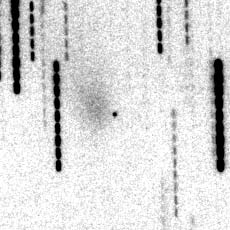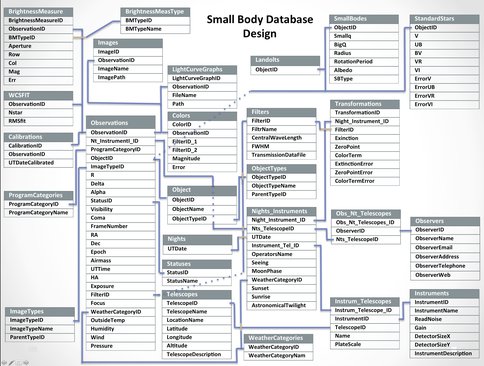2011 Annual Science Report
 University of Hawaii, Manoa
Reporting | SEP 2010 – AUG 2011
University of Hawaii, Manoa
Reporting | SEP 2010 – AUG 2011
Comet Activity and Composition
Project Summary
The study of primitive bodies as building blocks of the Solar System, and what they contribute to
the understanding of how the Solar System was constructed is central to the science goals laid out in the Planetary Decadal Survey. Objects in the Kuiper belt (KBOs) are remnant planetesimals with orbits beyond Neptune, with sizes small enough that they are relatively well preserved since the era of solar system formation. KBO surfaces exhibit a wide variety of colors, ranging from blue-neutral to reddish. This reflects both the underlying primordial chemical differences as well as radiation processing on their surfaces. Some of this population gets scattered into the inner solar system through dynamical interactions, and these, when observable form the Centaur class of objects. Comets, depending on their source region may have formed at a variety of distances and scattered early in the solar system’s history; some are now captured in the inner solar system due to the influence of Jupiter. Understanding the chemistry of these primordial leftovers is important as a clue to the early conditions in the solar system during the planet formation era. Our team is actively studying the composition of these objects through spectroscopy of their surfaces and the materials outgassed, by observing the level of dust and gas objects produce when they move into the inner solar system and through modeling their outgassing behavior.
Project Progress
“Comet Activity and Composition”
We continue to obtain observations of comets at large distances in order to constrain their nucleus sizes and rotation periods. This will be used in combination with ice sublimation and thermal evolution models to understand differences in chemical and microphysical properties of the nucleus. The goal is to use this to form a taxonomic classification of comets and use this to understand the distribution and migration of small bodies in the protosolar nebula. For those comets that become bright enough, we can observe the parent volatiles directly with high resolution near-IR spectroscopy, and we have begun a collaboration with M. Mumma and the NASA Goddard NAI team to maximize our ability to get compositional information for the volatile species.
“Surfaces of Kuiper Belt Objects”
A small subset of Kuiper Belt objects exhibit surface colors that are more neutral to blue compared to the color of the sun. Since cosmic irradiation of organics and ices tends to redden and darken the surfaces, it has been suggested that these objects have fresher surfaces, either due to recent collision, or re-surfacing by outgassing and volatile re-deposition. Graduate student S. Sonnett has been investigation these blue objects as part of her thesis, searching for variations in color and spectral signatures as a function of rotation. The Haumea family is currently the only known KBO collisional family, and many of its members have been observed to have higher albedos and water ice fractions. In a new collaboration with S. Desch from the ASU team we have developed new criteria for identification of Haumea family members based on the idea that the parent body was large enough to differentiate, and that not all the bodies will necessarily be icy. S. Sonnett has obtained spectra of one of these new candidates and is constructing spectral models of the surface materials.
Our work, lead by former UHNAI postdoc A. Delsanti, on the intermediate sized Orcus has now been completed. Spectra of this object shows a water-ice dominated surface similar to that of Pluto’s satellite Charon. Spectral models suggest the presence of ammonium and ethane, likely solar irradiation products of ammonia and methane. Thermal evolution model simulations of the interior show that Orcus should have differentiated, with the presence of ammonia in the interior aiding in the melting. It is likely that Orcus has suffered crytovolcanism.
“A Database for Long-Term Studies of Comets”
Study of primitive bodies addresses questions about the initial stages, conditions, and processes during solar system formation, and the sources of organic and volatile material for the Earth. As new large surveys produce small solar system body data, they enable a new science that involves studies of classes, secular evolution of physical characteristics and processes and interrelations. Our team has acquired a large amount of observations of small solar system bodies, and we have been designing the architecture for a database that will enable easy access to the data, and data products so that we can study the long-term behavior of comets, and ensemble collections of comets. Using this data, graduate student A. Zenn has been constructing dust-dynamical models of the dust coma for periodic comet 22P/Kopff, and has found that the coma can only be reproduced with outgassing from a localized source that had been without sunlight for several months, suggesting a deep source for the volatiles. We are coupling this with thermal evolution models to ascertain the volatiles responsible. Future plans include this type of modeling for comets in different dynamical classes for comparison.
{{2039}}
The schema developed for the comet –small body database that allows ready access to the imaging observations, all the ancillary data from the observations, as well as the reduced data products.

Image of comet 22P/Kopff with an unusual “nearly detached” dust tail at large distances from the sun. This peculiar appearance is reproduced for two perihelion passages, and is due to emission from a jet near the south pole long after the region was in darkness.
Publications
-
Delsanti, A., Merlin, F., Guilbert-Lepoutre, A., Bauer, J., Yang, B., & Meech, K. J. (2010). Methane, ammonia, and their irradiation products at the surface of an intermediate-size KBO?. A&A, 520, A40. doi:10.1051/0004-6361/201014296
-
Mumma, M. J., Bonev, B. P., Villanueva, G. L., Paganini, L., DiSanti, M. A., Gibb, E. L., … Magee-Sauer, K. (2011). TEMPORAL AND SPATIAL ASPECTS OF GAS RELEASE DURING THE 2010 APPARITION OF COMET 103P/HARTLEY 2. The Astrophysical Journal, 734(1), L7. doi:10.1088/2041-8205/734/1/l7
-
Paganini, L., Mumma, M. J., Bonev, B. P., Villanueva, G. L., DiSanti, M. A., Keane, J. V., & Meech, K. J. (2012). The formation heritage of Jupiter Family Comet 10P/Tempel 2 as revealed by infrared spectroscopy. Icarus, 218(1), 644–653. doi:10.1016/j.icarus.2012.01.004
-
PROJECT INVESTIGATORS:
-
PROJECT MEMBERS:
Karen Meech
Project Investigator
Audrey Delsanti
Co-Investigator
Steven Desch
Co-Investigator
Jacqueline Keane
Co-Investigator
Michael Mumma
Co-Investigator
Lucas Paganini
Co-Investigator
Gal Sarid
Co-Investigator
Jason Cook
Collaborator
Olivier Hainaut
Collaborator
Jan Kleyna
Collaborator
Timm Riesen
Collaborator
Heather Kaluna
Graduate Student
Laurie Urban
Graduate Student
Anthony Zenn
Graduate Student
-
RELATED OBJECTIVES:
Objective 2.2
Outer Solar System exploration
Objective 3.1
Sources of prebiotic materials and catalysts
